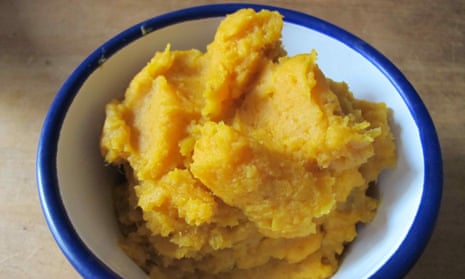Bright orange sweet potato mash with a slab of butter melting slowly on top is a familiar sight on Thanksgiving feast tables across north America. Not only delicious, the vegetable is increasingly recognised as a nutritional powerhouse. The intense colour means there is lots of beta-carotene, which the body converts into vitamin A. One small root provides the daily vitamin A needs for a child under five years of age. Sweet potato came out as the most nutritious food in an evaluation of 58 superfood vegetables by the US’s Centre for Science in the Public Interest.
In sub-Saharan Africa most locally grown varieties are white-fleshed, hence no beta-carotene. Production is often under the control of women; grown principally to eat, not to sell. Since women are the principal caregivers of the family, the introduction of the orange-flesh varieties emerges as a no-brainer. Over a third of children under five (36%) in sub-Saharan Africa suffer from vitamin A deficiency, which puts them at higher risk of falling ill, mortality and eye problems. Women in charge of the family diet and sweet-potato production can easily incorporate these new breeds of vitamin-rich orange-fleshed sweet potatoes into their diet.
Our work to improve nutrition and food security by harnessing the benefits of orange-fleshed sweet potatoes (OSP) in sub-Saharan Africa met a number of challenges.
First, sweet potato has been largely ignored by policymakers in the region, in part because it is widely perceived as a poor person’s food – the crop that you eat when the maize fails. Consequently, the number of researchers and programmes actually working on sweet potato is small.
Second, in sub-Saharan Africa sweet potato is grown by planting vines, not seeds. Vines are easily shared among friends and family usually for free. That means that close to non-existent private sector interest in sweet potato planting.
Third, OSP varieties grown in the Americas are low in dry matter (18-23%), making them easy to mash. In sub-Saharan Africa, adults have different tastes and local varieties have much higher dry matter levels (27-33%), giving the roots a floury texture. Initial attempts to introduce varieties bred outside of Africa had limited success. Children loved the color and actually preferred the easy to swallow, low-dry matter roots, but adults, who make the decision on what to plant, did not.
We needed evidence to prove the potential of the crop to improve vitamin A in young children. And we needed to raise awareness so that resources were allocated into breeding adapted OSP varieties that met consumer tastes. A tremendous advocacy effort was made.
OSP is the first biofortified food – that is food that is breed to concentrate the levels of vitamins and minerals. Vitamin A enhancement is done through conventional breeding as beta-carotene rich varieties exist in nature. From the outset, an integrated approach was used, combining breeding OSP varieties with nutrition education at the community level. OSP was never envisioned as a magic bullet miraculously solving the problem, but as an entry point for empowering caregivers to improve child feeding practices and overall household nutrition.
The orange flesh was something new and quite different from the existing varieties. As it turned out, the colour has proved to be a wonderful demand-creation tool. Promotion campaigns have associated the colour with good health and in Mozambique, OSP is known as the sweet that gives health.
Studies conducted in Mozambique and Uganda (2003-2010) provided solid evidence that the integrated agriculture-nutrition approach could result in doubling vitamin A intakes and significantly lowering the prevalence of vitamin A deficiency among young children (by 15% in Mozambique). That evidence convinced donors to further invest.
In 2009, the International Potato Centre in collaboration with over 25 partners launched the Sweetpotato for Profit and Health Initiative. It set the ambitious goal of enhancing the lives of 10 million households in 16 sub-Sahara African countries by 2020, combatting malnutrition and food insecurity through the diversified use of sweet potato. The first five years (2010-2014) focused on proving the potential; the second five (2015-2019) will be all about achieving the potential.
One of the major achievements so far has been building a strong community of sweet potato breeders in 12 African countries which interact and share best practice around the sweet potato knowledge portal. So far, over 950,000 households in 12 sub-Sahara African countries have received improved OSP materials and investments have been made in building networks of vine multipliers so that farmers can easily access quality planting material.
Can super sweet potatoes solve malnutrition in sub-Saharan Africa? The answer is no, but they can certainly make a significant contribution. A recent study (2010-2014) found that linking OSP and enhanced nutrition messages into healthcare services for pregnant women led to increased vitamin A intakes of mother and child and significantly reduced stunting (chronic malnutrition) among children under two.
The approach is complex but cost effective. Efforts are increasingly focused on improving markets, changing the image of sweet potato as a crop of the poor to a healthy food for all.
Jan Low is a project manager at International Potato Centre sub-Saharan Africa. Follow @Cipotato on Twitter.
Join our community of development professionals and humanitarians. Follow@GuardianGDP on Twitter.

Comments (…)
Sign in or create your Guardian account to join the discussion